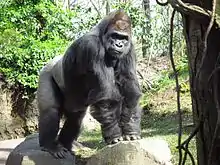Pongidae
Pongidae /ˈpɒndʒɪdiː/, or the pongids, is an obsolete primate taxon containing gorillas, chimpanzees and orangutans. They are sometimes called "great apes".[1] Pongidae is now known to be paraphyletic. Pongids split from Hominina around seven mya.[2] The corresponding crown group for this taxon is Hominidae. Pongidae has seven extant member species. This taxon is rarely used today but is of historical significance.[3][4]
| Pongidae Temporal range: Late Miocene to Recent | |
|---|---|
 | |
| Gorilla in the Bronx Zoo | |
| Scientific classification (obsolete) | |
| Kingdom: | Animalia |
| Phylum: | Chordata |
| Class: | Mammalia |
| Order: | Primates |
| Suborder: | Haplorhini |
| Infraorder: | Simiiformes |
| Superfamily: | Hominoidea |
| Family: | Pongidae Elliot, 1913 |
| Genera | |
Distinction to hominins
| Pongids | Humans[notes 1] | |
|---|---|---|
| Mode of locomotion | Knuckle walking, arboreal | Bipedalism |
| Location of foramen magnum | Back of the skull | Under the skull |
| Average brain capacity | 400 cc | 1700 cc |
| Skull (viewed from top) | pear-shaped | ovoid |
| Widest part of skull viewed from behind | Parietal region | Base of the skull(near the auditory region) |
| Palate | Rectangular | Parabolic |
| Body growth | Fast | Slow |
| Phalanges | Curved | Straight |
Skull
The pongid skull contains the following features that are absent or less pronounced in humans:
- a sulcus behind the brow ridges
- prognathism
- a protruding occipital region
- large, bony eye sockets
- a large nasal opening
- constriction just behind the orbital region
- stout facial bones
- a diastema
- a simian shelf
Adaptations for locomotion
The following adaptations are for arboreal and knuckle walking locomotion and are not found in humans:
| Pongid | Human |
|---|---|
| Arms are shorter than the legs | Arms are longer than the legs |
| Scapula has an orientation for supporting the body weight beneath the arms | Scapula is oriented for holding the arms by the side |
| Digits are long and curved for grasping branches | Digits are shorter and straight |
| Pelvis is shaped to support the legs and trunk in the bent-over posture | Pelvis is shaped to support the legs and trunk in a vertical position |
| Knees do not lock the legs | Knees lock the legs straight to minimize the expenditure of energy when standing |
| Pelvis is relatively large | Pelvis is much shorter and bowl-shaped |
| Iliac pillar is elongated | The iliac crest is oriented more to the side and slanted |
Similarity to hominins
The australopithecines show intermediate character states between pongids and humans, with Pithecanthropus intermediate between australopithecines and humans. Members of the genus Homo share many key features with anatomically modern man.
References
- "Pongid definition".
- Cordain, Loren (2007). "Implications of Plio-pleistocene diets for modern humans". In Peter S. Ungar (ed.). Evolution of the human diet: the known, the unknown and the unknowable. pp. 264–5.
"Since the evolutionary split between hominins and pongids approximately 7 million years ago, the available evidence shows that all species of hominins ate an omnivorous diet composed of minimally processed, wild-plant, and animal foods.
- "Shoshani J, Groves CP, Simons EL & Gunnell GF., 1996. Primate phylogeny: morphological vs. molecular results. Mol Phyl. Evol., 5(1):102-54". Archived from the original on 2011-05-31. Retrieved 2018-07-20.
- ITIS
- Humans are the only extant Homininans.